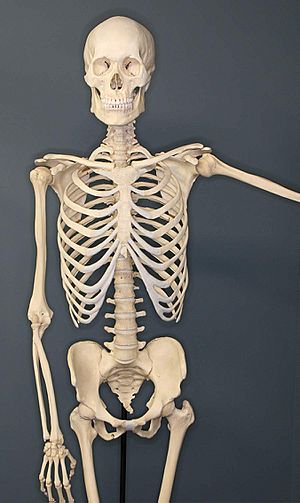Human skeleton facts for kids
The human skeleton is like the internal framework of your body. It gives you shape and helps you move. When you are born, you have about 300 bones. As you grow, some of these bones join together. By the time you are an adult, you will have 206 bones. Your bones are usually strongest around age 20.
Your skeleton has two main parts. The first part is the axial skeleton. This includes your spine, rib cage, and skull. It's the central part of your body. The second part is the appendicular skeleton. This part is attached to the axial skeleton. It includes your shoulders, hips, and the bones in your arms and legs.
The human skeleton does six important jobs. It supports your body, helps you move, and protects your organs. It also makes blood cells, stores important minerals, and helps control your hormones.
Male and female skeletons are quite similar. However, there are small differences. These differences can be seen in the skull, teeth, long bones, and pelvis. Generally, female bones are a bit smaller and less strong than male bones.
The female pelvis is wider than the male pelvis. This wider shape helps with childbirth. It creates a birth canal that allows a baby's head to pass through. A baby's head is much larger than in other animals.
Contents
How Your Skeleton Works
Your skeleton has six main jobs. These jobs are support, movement, protection, making blood cells, storing minerals, and controlling hormones.
Supporting Your Body
Your skeleton is the main support system for your body. It holds you up and keeps your shape. For example, your pelvis and rib cage help support your internal organs. Without your bones, your body would not be able to stand up. Your lungs would also collapse without the rib cage.
Helping You Move
Bones connect at joints, which allow you to move. Some joints, like your shoulder, allow a lot of movement. Others, like your neck, allow less. Your skeletal muscles are attached to your bones. When these muscles pull, they make your bones move. Your muscles, bones, and joints work together. Your nervous system helps control all these movements.
Scientists believe that human bones became less dense over time. This happened when people started farming instead of hunting. Less dense bones might have changed how humans moved.
Protecting Your Organs
Your skeleton acts like a shield for your important internal organs.
- Your skull protects your brain.
- Your vertebrae (the bones in your spine) protect your spinal cord.
- Your rib cage, spine, and sternum protect your lungs, heart, and major blood vessels.
Making Blood Cells
Your bones are where new blood cells are made. This process is called haematopoiesis. It happens in the soft center of your bones, called bone marrow. In children, blood cells are made mostly in the long bones like the thigh bone (femur). In adults, they are made mainly in the pelvis, skull, vertebrae, and sternum.
Storing Important Minerals
Your bones can store important minerals like calcium. Calcium is very important for many body functions. Bones are not just made of calcium. They are a mix of different substances. One main part is called hydroxyapatite, which contains calcium and phosphorus. Another part is chondroitin sulfate, which is a type of sugar. Your bone marrow also stores iron.
Controlling Hormones
Bone cells release a hormone called osteocalcin. This hormone helps control your blood sugar levels. It also helps manage how your body stores fat. Osteocalcin can increase how much insulin your body makes. It also makes your body more sensitive to insulin. This helps keep your energy levels balanced.
Images for kids
-
During construction of the York to Scarborough Railway Bridge in 1901, workers found a large stone coffin. Inside was a skeleton with many unusual and expensive objects. This was a very important discovery from Roman York. Studies showed the skeleton belonged to a woman.
See also
 In Spanish: Esqueleto humano para niños
In Spanish: Esqueleto humano para niños



